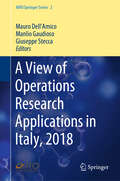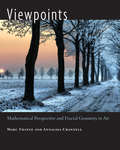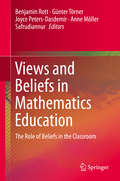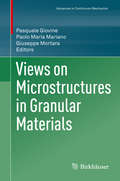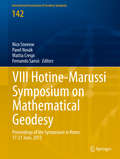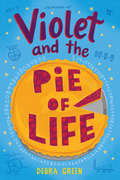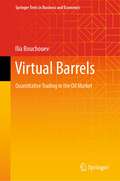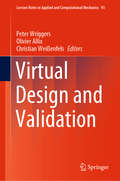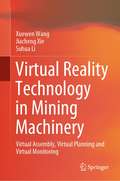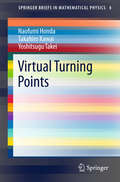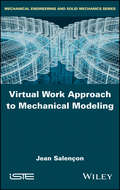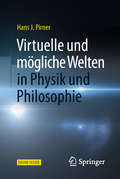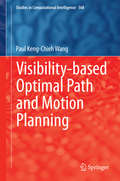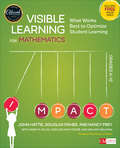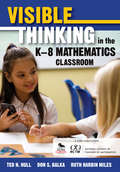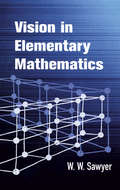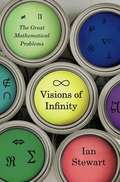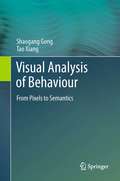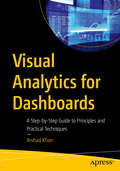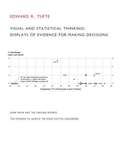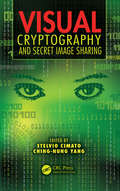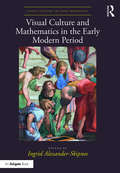- Table View
- List View
A View of Operations Research Applications in Italy, 2018 (AIRO Springer Series #2)
by Mauro Dell’Amico Manlio Gaudioso Giuseppe SteccaThis book presents expert descriptions of the successful application of operations research in both the private and the public sector, including in logistics, transportation, product design, production planning and scheduling, and areas of social interest. Each chapter is based on fruitful collaboration between researchers and companies, and company representatives are among the co-authors. The book derives from a 2017 call by the Italian Operations Research Society (AIRO) for information from members on their activities in promoting the use of quantitative techniques, and in particular operations research techniques, in society and industry. A booklet based on this call was issued for the annual AIRO conference, but it was felt that some of the content was of such interest that it deserved wider dissemination in more detailed form. This book is the outcome. It equips practitioners with solutions to real-life decision problems, offers researchers examples of the practical application of operations research methods, and provides Master’s and PhD students with suggestions for research development in various fields.
Viewpoints: Mathematical Perspective and Fractal Geometry in Art
by Marc Frantz Annalisa CrannellAn undergraduate textbook devoted exclusively to relationships between mathematics and art, Viewpoints is ideally suited for math-for-liberal-arts courses and mathematics courses for fine arts majors. The textbook contains a wide variety of classroom-tested activities and problems, a series of essays by contemporary artists written especially for the book, and a plethora of pedagogical and learning opportunities for instructors and students. Viewpoints focuses on two mathematical areas: perspective related to drawing man-made forms and fractal geometry related to drawing natural forms. Investigating facets of the three-dimensional world in order to understand mathematical concepts behind the art, the textbook explores art topics including comic, anamorphic, and classical art, as well as photography, while presenting such mathematical ideas as proportion, ratio, self-similarity, exponents, and logarithms. Straightforward problems and rewarding solutions empower students to make accurate, sophisticated drawings. Personal essays and short biographies by contemporary artists are interspersed between chapters and are accompanied by images of their work. These fine artists--who include mathematicians and scientists--examine how mathematics influences their art. Accessible to students of all levels, Viewpoints encourages experimentation and collaboration, and captures the essence of artistic and mathematical creation and discovery. Classroom-tested activities and problem solving Accessible problems that move beyond regular art school curriculum Multiple solutions of varying difficulty and applicability Appropriate for students of all mathematics and art levels Original and exclusive essays by contemporary artists Forthcoming: Instructor's manual (available only to teachers)
Views and Beliefs in Mathematics Education: The Role Of Beliefs In The Classroom
by Benjamin Rott Günter Törner Joyce Peters-Dasdemir Anne Möller SafrudiannurThe book is made up of 21 chapters from 25 presentations at the 23rd MAVI conference in Essen, which featured Alan Schoenfeld as keynote speaker. Of major interest to MAVI participants is the relationship between teachers’ professed beliefs and classroom practice. The first section is dedicated to classroom practices and beliefs regarding those practices, taking a look at prospective or practicing teachers’ views of different practices such as decision-making, the roles of explanations, problem-solving, patterning, and the use of play. The focus of the second section in this book deals with teacher change, which is notoriously difficult, even when the teachers themselves are interested in changing their practice. The third section of this book centers on the undercurrents of teaching and learning mathematics, what rises in various situations, causing tensions and inconsistencies. The last section of this book takes a look at emerging themes in affect-related research. In this section, papers discuss attitudes towards assessment.
Views on Microstructures in Granular Materials (Advances in Mechanics and Mathematics #44)
by Pasquale Giovine Paolo Maria Mariano Giuseppe MortaraThis contributed volume provides an up-to-date overview of the mechanics of granular materials, ranging from sparse media to soils. With chapters exploring state-of-the-art theoretical, experimental, and applied trends in the study of granular matter in various states, readers will be motivated to learn about the current challenges and potential avenues of exploration in this active area of research. Including a variety of perspectives, this volume will be a valuable reference for audiences in a number of fields. Specific topics covered include:X-ray tomography techniques for analyzing sandEvaluation of effective stress in unsaturated soilsHyper-plasticityWave propagation in granular systemsPartly saturated porous mediaMulti-scale approaches to the dynamics of sparse mediaViews on Microstructures in Granular Materials is an ideal resource for PhD students and researchers in applied mathematics, solid-state physics, civil engineering, and mechanical engineering.
VII Hotine-Marussi Symposium on Mathematical Geodesy
by Pavel Novák Nico Sneeuw Mattia Crespi Fernando SansòThe Hotine-Marussi Symposium is the core meeting of a "think thank", a group scientists in the geodetic environment working on theoretical and methodological subjects, while maintaining the foundations of geodesy to the proper level by corresponding to the strong advancements improved by technological development in the field of ICT, electronic computing, space technology, new measurement devices etc. The proceedings of the symposium cover a broad area of arguments which integrate the foundations of geodesy as a science. The common feature of the papers therefore is not on the object, but rather in the high mathematical standards with which subjects are treated.
Violence in the Heights: The Torn Social Fabric of Inner-city Neighborhoods (Criminology and Justice Studies)
by Eileen M. AhlinGiven the media attention and research focus on big cities with large minority populations, people have grown accustomed to associating violence with these attributes. Violence in the Heights counters that narrative to provide a fresh perspective on inner-city violence with a close look at violence and associated social disorder in a cluster of neighborhoods in a mid-sized, predominantly White city. Eileen M. Ahlin studied 42 residents and their perceptions of and responses to violence to give voice to their experiences. Ahlin provides a historical overview of the neighborhoods and highlights a series of pivotal violent events, and discovers how they differentially impacted residents and their perceptions of safety. Residents reveal how institutional and demographic shifts reduced interpersonal connections and weakened the community's social fabric. A unique take on inner-city violence, Violence in the Heights also details why residents move to other communities when violence increases or, if they remain, adapt to changing conditions. This book will interest mainstream readers interested in learning about urban affairs and the human-interest story as it will track why inner-city residents stay in their neighborhoods or move to other communities when violence increases. This book will also serve as an academic text to outline the changes in violence and community disorder in a mid-sized city that is predominantly White, an understudied aspect of urban violence.
Violet and the Pie of Life
by D. L. GreenThere's no golden ratio for a family, despite what number-crunching Violet might think.Twelve-year-old Violet has two great loves in her life: math and pie. And she loves her parents, even though her mom never stops nagging and her dad can be unreliable. Mom plus Dad doesn't equal perfection. Still, Violet knows her parents could solve their problems if they just applied simple math. #1: Adjust the ratio of Mom's nagging to her compliments. #2: Multiply Dad's funny stories by a factor of three. #3: Add in romantic stuff wherever possible. But when her dad walks out, Violet realizes that the odds do not look good. Why can't her parents get along like popular, perfect Ally's parents? Would it be better to have no dad at all, like her best friend, McKenzie? Violet is considering the data when she and Ally get cast in the school play, and McKenzie doesn't--a probability that Violet never calculated. Maybe friendship and family have more variables than she thought.Filled with warmth, math-y humor, and delicious pie, this heartfelt middle grade read is perfect for fans of The Miscalculations of Lightning Girl. Includes illustrated charts, graphs, and diagrams throughout.
Virtual Barrels: Quantitative Trading in the Oil Market (Springer Texts in Business and Economics)
by Ilia BouchouevThe global oil market is no longer solely influenced by the supply and demand of physical oil barrels. In today's landscape, financial barrels traded by hedge funds using quantitative algorithms and dealers managing large portfolios of oil derivatives are equally crucial in determining the price of oil. This book offers a fascinating insight into the world of oil derivatives, exploring the quantitative models and trading strategies used by professional market participants. With a focus on oil options and volatility trading, the reader is taken on a journey through the story of this market, narrated by one of its pioneers who managed a highly successful trading business for almost a quarter of a century. Bridging the fields of energy economics and mathematical finance, this book demonstrates how the science of trading can unearth unique opportunities in the oil market. Written for aspiring quantitative traders and academic researchers alike, it offers a rare glimpse into the opaque and secretive world of oil derivatives, showcasing how it operates in practice.
Virtual Design and Validation (Lecture Notes in Applied and Computational Mechanics #93)
by Peter Wriggers Olivier Allix Christian WeißenfelsThis book provides an overview of the experimental characterization of materials and their numerical modeling, as well as the development of new computational methods for virtual design. Its 17 contributions are divided into four main sections: experiments and virtual design, composites, fractures and fatigue, and uncertainty quantification. The first section explores new experimental methods that can be used to more accurately characterize material behavior. Furthermore, it presents a combined experimental and numerical approach to optimizing the properties of a structure, as well as new developments in the field of computational methods for virtual design. In turn, the second section is dedicated to experimental and numerical investigations of composites, with a special focus on the modeling of failure modes and the optimization of these materials. Since fatigue also includes wear due to frictional contact and aging of elastomers, new numerical schemes in the field of crack modeling and fatigue prediction are also discussed. The input parameters of a classical numerical simulation represent mean values of actual observations, though certain deviations arise: to illustrate the uncertainties of parameters used in calculations, the book’s final section presents new and efficient approaches to uncertainty quantification.
Virtual Reality Technology in Mining Machinery: Virtual Assembly, Virtual Planning and Virtual Monitoring
by Xuewen Wang Jiacheng Xie Suhua LiThis book focuses on the application of virtual reality (VR) technology in mining machinery. It gives a detailed introduction to the application of VR technology in virtual assembly, virtual planning, and virtual monitoring. Based on the theory of digital twin, VR technology and collaborative control technology are applied to coal mining machinery equipment, which lays a foundation for the digitalization and intellectualization of coal machinery equipment and broadens the application scope of virtual reality technology in the mechanical engineering field. Through the application of VR technology in coal machinery equipment, this book provides new methods and ideas for teaching activities, scientific research activities, and actual production with rich illustrations, related table introduction, unique research ideas, and other unique contents. This book could be a useful reference for researchers in mining machinery, simulation and modeling, computer-aided engineering (CAD and CAE) and design, visualization, mechanical engineering, and other disciplines.
Virtual Turning Points
by Naofumi Honda Takahiro Kawai Yoshitsugu TakeiThe discovery of a virtual turning point truly is a breakthrough in WKB analysis of higher order differential equations. This monograph expounds the core part of its theory together with its application to the analysis of higher order Painlevé equations of the Noumi-Yamada type and to the analysis of non-adiabatic transition probability problems in three levels. As M. V. Fedoryuk once lamented, global asymptotic analysis of higher order differential equations had been thought to be impossible to construct. In 1982, however, H. L. Berk, W. M. Nevins, and K. V. Roberts published a remarkable paper in the Journal of Mathematical Physics indicating that the traditional Stokes geometry cannot globally describe the Stokes phenomena of solutions of higher order equations; a new Stokes curve is necessary.
Virtual Work Approach to Mechanical Modeling
by Jean SalençonThis book is centred about the Principle of virtual work and the related method for mechanical modelling. It aims at showing and enhancing the polyvalence and versatility of the virtual work approach in the mechanical modelling process. The virtual work statement is set as the principle at the root of a force modelling method that can be implemented on any geometrical description. After experimentally induced hypotheses have been made on the geometrical parameters that describe the concerned system and subsystems, the method provides a unifying framework for building up consistently associated force models where external and internal forces are introduced through their virtual rates of work. Systems described as three-dimensional, curvilinear or planar continua are considered: force models are established with the corresponding equations of motion; the validation process points out that enlarging the domain of relevance of the model for practical applications calls for an enrichment of the geometrical description that takes into account the underlying microstructure.
Virtuelle und mögliche Welten in Physik und Philosophie
by Hans J. PirnerWas sind mögliche Welten und was haben Entwicklungen der modernen Physik mit Ideen über mögliche Welten in der Philosophie zu tun? In der Beantwortung dieser Fragen entwickelt das vorliegende Werk das wissenschaftliche Weltbild im Vergleich mit möglichen Welten und gelangt so zu einem besseren Verständnis unserer einzigen wirklichen Welt. Dazu beschreibt der Autor die kreativen Ideen, die zur klassischen Physik, zur Quantenphysik und zur Erforschung des Ursprungs des Weltalls geführt haben. Er lädt den Leser ein, mit ihm über die Versuche in der modernen Physik nachzudenken, Parallelwelten und neue Universen einzuführen. Man erfährt, wie in Physik und Philosophie mögliche Welten als Instrumente verwendet werden, um unsere Erkenntnisse zu erweitern. Es wird erläutert, wie man sich mögliche Welten auch außerhalb der Physik vorzustellen hat und welchen Anforderungen diesen genügen. Unter diesem Gesichtspunkt analysiert der Autor abschließend die Zukunftsvisionen der Science-Fiction Literatur und die neuesten Erkenntnisse über künstliche, virtuelle und hybride Welten. Anhänge mit vertieftem physikalischen Hintergrund und ein ausführliches Glossar unterstützen die interessierten Lesern und Leserinnen dabei, einen Überblick über die vielfältigen Begriffe und Sachverhalte zu behalten.
Virus Host Cell Genetic Material Transport: Computational ODE/PDE Modeling with R
by William E. SchiesserThe reproduction and spread of a virus during an epidemic proceeds when the virus attaches to a host cell and viral genetic material (VGM) (protein, DNA, RNA) enters the cell, then replicates, and perhaps mutates, in the cell. The movement of the VGM across the host cell outer membrane and within the host cell is a spatiotemporal dynamic process that is modeled in this book as a system of ordinary and partial differential equations (ODE/PDEs). The movement of the virus proteins through the cell membrane is modeled as a diffusion process expressed by the diffusion PDE (Fick’s second law). Within the cell, the time variation of the VGM is modeled as ODEs. The evolution of the dependent variables is computed by the numerical integration of the ODE/PDEs starting from zero initial conditions (ICs). The departure of the dependent variables from zero is in response to the virus protein concentration at the outer membrane surface (the point at which the virus binds to the host cell). The numerical integration of the ODE/PDEs is performed with routines coded (programmed) in R, a quality, open-source scientific computing system that is readily available from the Internet. Formal mathematics is minimized, e.g., no theorems and proofs. Rather, the presentation is through detailed examples that the reader/researcher/analyst can execute on modest computers. The ODE/PDE dependent variables are displayed graphically with basic R plotting utilities. The R routines are available from a download link so that the example models can be executed without having to first study numerical methods and computer coding. The routines can then be applied to variations and extensions of the ODE/PDE model, such as changes in the parameters and the form of the model equations.
Visibility-based Optimal Path and Motion Planning
by Paul Keng-Chieh WangThis monograph deals with various visibility-based path and motion planning problems motivated by real-world applications such as exploration and mapping planetary surfaces, environmental surveillance using stationary or mobile robots, and imaging of global air/pollutant circulation. The formulation and solution of these problems call for concepts and methods from many areas of applied mathematics including computational geometry, set-covering, non-smooth optimization, combinatorial optimization and optimal control. Emphasis is placed on the formulation of new problems and methods of approach to these problems. Since geometry and visualization play important roles in the understanding of these problems, intuitive interpretations of the basic concepts are presented before detailed mathematical development. The development of a particular topic begins with simple cases illustrated by specific examples, and then progresses forward to more complex cases. The intended readers of this monograph are primarily students and researchers in engineering, computer science and applied mathematics. An understanding of the mathematical development of the main results requires only basic knowledge of mathematical analysis, control, and optimization theories. Some exercises with various degrees of difficulty are provided at the end of the main chapters. The material presented here may serve as a portion of an introductory course or seminar on visibility-based optimal path and motion planning problems with the objective of stimulating interest and further studies in this relatively new area.
Visible Learning for Mathematics, Grades K-12: What Works Best to Optimize Student Learning (Corwin Mathematics Series)
by Douglas Fisher John Hattie Dr Nancy Frey Linda M. Gojak Sara Delano Moore William L. MellmanRich tasks, collaborative work, number talks, problem-based learning, direct instruction…with so many possible approaches, how do we know which ones work the best? In Visible Learning for Mathematics, six acclaimed educators assert it’s not about which one—it’s about when—and show you how to design high-impact instruction so all students demonstrate more than a year’s worth of mathematics learning for a year spent in school. That’s a high bar, but with the amazing K-12 framework here, you choose the right approach at the right time, depending upon where learners are within three phases of learning: surface, deep, and transfer. This results in “visible” learning because the effect is tangible. The framework is forged out of current research in mathematics combined with John Hattie’s synthesis of more than 15 years of education research involving 300 million students. Chapter by chapter, and equipped with video clips, planning tools, rubrics, and templates, you get the inside track on which instructional strategies to use at each phase of the learning cycle: Surface learning phase: When—through carefully constructed experiences—students explore new concepts and make connections to procedural skills and vocabulary that give shape to developing conceptual understandings. Deep learning phase: When—through the solving of rich high-cognitive tasks and rigorous discussion—students make connections among conceptual ideas, form mathematical generalizations, and apply and practice procedural skills with fluency. Transfer phase: When students can independently think through more complex mathematics, and can plan, investigate, and elaborate as they apply what they know to new mathematical situations. To equip students for higher-level mathematics learning, we have to be clear about where students are, where they need to go, and what it looks like when they get there. Visible Learning for Math brings about powerful, precision teaching for K-12 through intentionally designed guided, collaborative, and independent learning.
Visible Learning for Mathematics, Grades K-12: What Works Best to Optimize Student Learning (Corwin Mathematics Series)
by Douglas Fisher John Hattie Dr Nancy Frey Linda M. Gojak Sara Delano Moore William L. MellmanRich tasks, collaborative work, number talks, problem-based learning, direct instruction…with so many possible approaches, how do we know which ones work the best? In Visible Learning for Mathematics, six acclaimed educators assert it’s not about which one—it’s about when—and show you how to design high-impact instruction so all students demonstrate more than a year’s worth of mathematics learning for a year spent in school. That’s a high bar, but with the amazing K-12 framework here, you choose the right approach at the right time, depending upon where learners are within three phases of learning: surface, deep, and transfer. This results in “visible” learning because the effect is tangible. The framework is forged out of current research in mathematics combined with John Hattie’s synthesis of more than 15 years of education research involving 300 million students. Chapter by chapter, and equipped with video clips, planning tools, rubrics, and templates, you get the inside track on which instructional strategies to use at each phase of the learning cycle: Surface learning phase: When—through carefully constructed experiences—students explore new concepts and make connections to procedural skills and vocabulary that give shape to developing conceptual understandings. Deep learning phase: When—through the solving of rich high-cognitive tasks and rigorous discussion—students make connections among conceptual ideas, form mathematical generalizations, and apply and practice procedural skills with fluency. Transfer phase: When students can independently think through more complex mathematics, and can plan, investigate, and elaborate as they apply what they know to new mathematical situations. To equip students for higher-level mathematics learning, we have to be clear about where students are, where they need to go, and what it looks like when they get there. Visible Learning for Math brings about powerful, precision teaching for K-12 through intentionally designed guided, collaborative, and independent learning.
Visible Thinking in the K–8 Mathematics Classroom
by Ted H. Hull Don S. Balka Ruth Harbin MilesSeeing is believing with this interactive approach to math instruction Do you ever wish your students could read each other’s thoughts? Now they can—and so can you! This newest book by veteran mathematics educators provides instructional strategies for maximizing students’ mathematics comprehension by integrating visual thinking into the classroom. Included are numerous grade-specific sample problems for teaching essential concepts such as number sense, fractions, and estimation. Among the many benefits of visible thinking are: Interactive student-to-student learning; Increased class participation; Development of metacognitive thinking and problem-solving skills.
Vision in Elementary Mathematics (Dover Books on Mathematics)
by W. W. SawyerHere is a presentation of elementary mathematics that anyone can appreciate, especially anyone with a capacity for imagination. As the title suggests, the author's technique relies on visual elements, and his approach employs the most graphic and least forbidding aspects of mathematics. Most people, he observes, possess a direct vision that permits them to "see" the smaller numbers; with the larger numbers, however, vision fails and mental chaos ensues. In addressing this difficulty, both for those who like recreational mathematics and particularly for teachers, the author suggests a variety of methods already used by many effective teachers -- techniques of visualizing, dramatizing, and analyzing numbers that attract and retain the attention and understanding of children. His topics range from basic multiplication and division to algebra, encompassing word problems, graphs, negative numbers, fractions, and many other practical applications of elementary mathematics.
Visions of Infinity: The Great Mathematical Problems
by Ian StewartIt is one of the wonders of mathematics that, for every problem mathematicians solve, another awaits to perplex and galvanize them. Some of these problems are new, while others have puzzled and bewitched thinkers across the ages. <P><P>Such challenges offer a tantalizing glimpse of the field's unlimited potential, and keep mathematicians looking toward the horizons of intellectual possibility. In Visions of Infinity, celebrated mathematician Ian Stewart provides a fascinating overview of the most formidable problems mathematicians have vanquished, and those that vex them still. He explains why these problems exist, what drives mathematicians to solve them, and why their efforts matter in the context of science as a whole. The three-century effort to prove Fermat's last theorem-first posited in 1630, and finally solved by Andrew Wiles in 1995-led to the creation of algebraic number theory and complex analysis. The Poincaré conjecture, which was cracked in 2002 by the eccentric genius Grigori Perelman, has become fundamental to mathematicians' understanding of three-dimensional shapes. But while mathematicians have made enormous advances in recent years, some problems continue to baffle us. Indeed, the Riemann hypothesis, which Stewart refers to as the "Holy Grail of pure mathematics," and the P/NP problem, which straddles mathematics and computer science, could easily remain unproved for another hundred years. An approachable and illuminating history of mathematics as told through fourteen of its greatest problems, Visions of Infinity reveals how mathematicians the world over are rising to the challenges set by their predecessors-and how the enigmas of the past inevitably surrender to the powerful techniques of the present.
Visual Analysis of Behaviour
by Shaogang Gong Tao XiangThis book presents a comprehensive treatment of visual analysis of behaviour from computational-modelling and algorithm-design perspectives. Topics: covers learning-group activity models, unsupervised behaviour profiling, hierarchical behaviour discovery, learning behavioural context, modelling rare behaviours, and "man-in-the-loop" active learning; examines multi-camera behaviour correlation, person re-identification, and "connecting-the-dots" for abnormal behaviour detection; discusses Bayesian information criterion, Bayesian networks, "bag-of-words" representation, canonical correlation analysis, dynamic Bayesian networks, Gaussian mixtures, and Gibbs sampling; investigates hidden conditional random fields, hidden Markov models, human silhouette shapes, latent Dirichlet allocation, local binary patterns, locality preserving projection, and Markov processes; explores probabilistic graphical models, probabilistic topic models, space-time interest points, spectral clustering, and support vector machines.
Visual Analytics for Dashboards: A Step-by-Step Guide to Principles and Practical Techniques
by Arshad KhanThis book covers the key principles, best practices, and practical techniques for designing and implementing visually compelling dashboards. It explores the various stages of the dashboard development process, from understanding user needs and defining goals, to selecting appropriate visual encodings, designing effective layouts, and employing interactive elements. It also addresses the critical aspect of data storytelling, examining how narratives and context can be woven into dashboards to deliver impactful insights and engage audiences. Visual Analytics for Dashboards is designed to cater to a wide range of readers, from beginners looking to grasp the fundamentals of visual analytics, to seasoned professionals seeking to enhance their dashboard design skills. For different types of readers, such as a data analyst, BI professional, data scientist, or simply someone interested in data visualization, this book aims to equip them with the knowledge and tools necessary to create impactful dashboards. What you’ll learn The principles of data visualization How to create effective dashboards Meet all the requirements for visual analytics/data visualization/dashboard courses Deepen understanding of data presentation and analysis How to use different kinds of tools for data analysis, such as scorecards and key performance indicators Who This Book Is For Business analysts, data analysts, BI professionals, end-users, executives, developers, as well as students in dashboards, data visualizations, and visual analytics courses.
Visual and Statistical Thinking: Displays of Evidence for Deicision Making
by Edward R. TufteThis booklet meant for students of quantitative thinking, reproduces chapter 2 of his other book Visual Explanations, Here we see two complex cases of the analysis and display of evidence--the celebrated investigation of a cholera epidemic by Dr. John Snow and the unfortunate decision to launch the space shuttle Challenger.
Visual Cryptography and Secret Image Sharing
by Stelvio Cimato Ching-Nung YangWith rapid progress in Internet and digital imaging technology, there are more and more ways to easily create, publish, and distribute images. Considered the first book to focus on the relationship between digital imaging and privacy protection, Visual Cryptography and Secret Image Sharing is a complete introduction to novel security methods and sharing-control mechanisms used to protect against unauthorized data access and secure dissemination of sensitive information. Image data protection and image-based authentication techniques offer efficient solutions for controlling how private data and images are made available only to select people. Essential to the design of systems used to manage images that contain sensitive data—such as medical records, financial transactions, and electronic voting systems—the methods presented in this book are useful to counter traditional encryption techniques, which do not scale well and are less efficient when applied directly to image files. An exploration of the most prominent topics in digital imaging security, this book discusses: Potential for sharing multiple secrets, Visual cryptography schemes—based either on the probabilistic reconstruction of the secret image, or on different logical operations for combining shared images, Inclusion of pictures in the distributed shares, Contrast enhancement techniques, Color-image visual cryptography, Cheating prevention, Alignment problems for image shares, Steganography and authentication In the continually evolving world of secure image sharing, a growing number of people are becoming involved as new applications and business models are being developed all the time. This contributed volume gives academicians, researchers, and professionals the insight of well-known experts on key concepts, issues, trends, and technologies in this emerging field.
Visual Culture and Mathematics in the Early Modern Period (Visual Culture in Early Modernity)
by Ingrid Alexander-SkipnesDuring the early modern period there was a natural correspondence between how artists might benefit from the knowledge of mathematics and how mathematicians might explore, through advances in the study of visual culture, new areas of enquiry that would uncover the mysteries of the visible world. This volume makes its contribution by offering new interdisciplinary approaches that not only investigate perspective but also examine how mathematics enriched aesthetic theory and the human mind. The contributors explore the portrayal of mathematical activity and mathematicians as well as their ideas and instruments, how artists displayed their mathematical skills and the choices visual artists made between geometry and arithmetic, as well as Euclid’s impact on drawing, artistic practice and theory. These chapters cover a broad geographical area that includes Italy, Switzerland, Germany, the Netherlands, France and England. The artists, philosophers and mathematicians whose work is discussed include Leon Battista Alberti, Nicholas Cusanus, Marsilio Ficino, Francesco di Giorgio, Leonardo da Vinci and Andrea del Verrocchio, as well as Michelangelo, Galileo, Piero della Francesca, Girard Desargues, William Hogarth, Albrecht Dürer, Luca Pacioli and Raphael.
